Searching For The Unknown
Astral Worlds by K.D.A.G. 2004
Written by Lachie Dazdarian(June, 2005)
Welcome to the first article in a new series by Lachie Dazdarian called "Searching For The Unknown". In these articles, Lachie will search out and review rare and unknown QB games that deserve much more recognition than they're getting. This month, he takes a look at Astral Worlds by K.D.A.G.. Enjoy!
-Pete
About Astral Worlds
Astral Worlds is a very interesting game maker also featuring a very nice role playing/action game called Chief Dojoepa! but first I would like to start with a short prelude.
At the first glance I thought Astral Worlds was some sort of low quality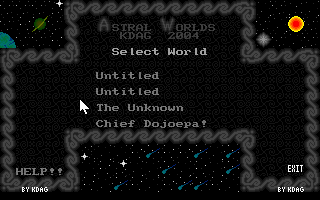 and sloppy piece of work since the source code was not compiled and contained hard paths. For the program to work it's files supposed to be placed in c:\aws directory which is not a big problem itself since Astral Worlds was zipped as "aws" directory. But for someone who plays games on his D: directory and unzips games to directories he creates this can be quite a drag. Also, the user is not warned in any sort of documentation where the program has to be unzipped. Very user-unfriendly. Once I got rid of the hard paths and started the program my opinion about Astral Worlds completely changed.
and sloppy piece of work since the source code was not compiled and contained hard paths. For the program to work it's files supposed to be placed in c:\aws directory which is not a big problem itself since Astral Worlds was zipped as "aws" directory. But for someone who plays games on his D: directory and unzips games to directories he creates this can be quite a drag. Also, the user is not warned in any sort of documentation where the program has to be unzipped. Very user-unfriendly. Once I got rid of the hard paths and started the program my opinion about Astral Worlds completely changed.
Astral Worlds looks and feels very unique and unconventional. The graphic design is quite nice, featuring cool, mystic-looking menus and menu illustrations. Right from the main menu you will notice that Astral Worlds is different from most of the other QBasic games you've played. On the main menu you are asked to pick a world and since the original version of Astral Worlds features only one completed world/game(Chief Dojoepa!) you will probably click on it. After you enter a world you will be able to start a new game, load a previously saved game or edit that world. Simply the way editing of a world/game and starting a new game are interlined makes Astral Worlds special. Not that this kind of design is the smartest idea which I'll explain later.
I will start with the review of the world editor simply because Chief Dojoepa! is a product of it.
The World Editor/Game Maker
Astral Worlds is basically a game maker and Chief Dojoepa! only a game made with it and not an integral part of the program. I'm not sure if Chief Dojoepa! was planned from the beginning but Astral Worlds definitely benefits from featuring it. It shows the full potential of the world editor but also in some way hides it's flaws. On the end the world editor ends up being the weaker part of the Astral Worlds package which probably wasn't the original intention of the author.
To access the world editor simply click on "Edit This World" option once you pick a world from the main menu. Don't use Chief Dojoepa! world to test or play with the editor. Use one of the empty world slots(Untitled world).
The biggest positive aspect of the world editor is it's user-friendliness. It's a very intuitive and well designed game maker, easy and enjoyable to use. On the other hand, there are the numerous limitations.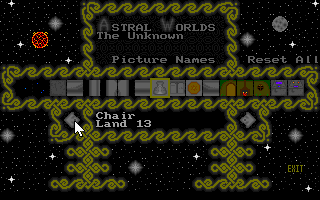 The main is that your game will be tile by tile scrolling and will feature Astral Worlds game screen design and the specific game mechanics. But I want to say something about the limitations of the very world editor first.
The main is that your game will be tile by tile scrolling and will feature Astral Worlds game screen design and the specific game mechanics. But I want to say something about the limitations of the very world editor first.
Each world you edit in Astral Worlds is consisted of four areas and each area is 50*50 tiles large. Each tile is 16*16 pixels large and each area features it's own 240 tiles. That's the most notable world editor restriction and this can't be changed, nor the tile size nor the map size. You might feel that it's impossible to create any kind of serious game with four 50*50 tiles large maps but if you try out Chief Dojoepa! you'll realize how mistaken you are. I really don't consider this to be the biggest problem of the world editor.
What you will notice first, after you access the tile/sprite editor("Edit Pictures" option in Area menu), is that all of the 240 area tiles have an already preset type(they are categorized). Tile slots are reserved for things like character sprites, objects(items), colliding and non-colliding tiles or animated tiles. You can change the tiles but not their type. So you can't use one animated tile to create an inanimate wall since it will be ALWAYS animated inside the game with it's other preset animation tiles(4 tiles make one animation). To prevent animation you would have to paste that wall tile in the remaining 3 tile slots used to enable that specific animation. Same thing with using item tile slots to store your non-colliding tiles or anything else. You simply can't do that. You must draw your game items in those slots. And the number of non-colliding tiles is, by my opinion, too small. Also, you can't be sure which tile is colliding or not since you can't always decipher that from the "name" of the tile type. Half of "Land" type tiles are colliding while the other half is not. The fact that each world already features all the sprites and tiles drawn(mostly cool) you will be able to figure out, according to their look, which tile does what when put into a game. You will be mostly annoyed with the already mentioned tile categorization.
The very designing of the world you should start from the "World Properties" menu. In it you can change the title of the world(game), new game information(starting position, character's strength, items he caries, ...), start and end game book(text and pictures shown on the beginning and the end of the game), world items, bombs and weapons. Start and end book feature is quite cool and allows you to create text and illustrations which are displayed in a form of a book on the beginning and the end of the game. "Edit Intro" option allows you to edit a book displayed before each new game and "Edit Ending" option to edit a book displayed after the game ends. To create illustrations you can use one of the 240 tiles reserved exclusively for the start/end book graphics and don't have anything to do with the area tiles(you don't have to worry about tile types; we are talking here about non-interactive illustrations). This is a really cool feature in the world editor and I can't say nothing bad about it. What you will notice in "Edit Items" menu is that one world can only feature 6 different objects(items). This was a big disappointment to me. I should mention that items don't include keys, weapons or bombs. Keys have reserved slots in the tilesets and are used with a specific type of event(Key Lock). I'll explain implementing events later. Each item you can connect with one of the events you create. It can be from increasing player's health(food and similar items in your game) to player being transported to X, Y position(items like magic stones or teleporting devices). You will also notice in "World Properties" menu that your game can only feature 3 types of weapons and 2 types of bombs. I didn't find this restrictive as the small number of items you can implement.
Inside every area menu you can edit the area map, add new events or edit the old ones, 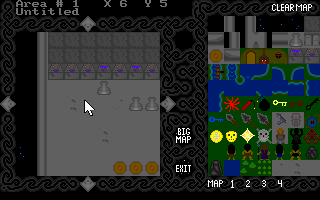 edit enemy characteristics, edit NPC characteristics, edit tiles/sprites and name tiles/sprites. Map editing is quite simple and does not require much comment. You pick tiles with right mouse button and place them with left mouse button. I should mention that you put movable objects, NPCs and enemies in the maps the same way as static tiles(no layers). By implementing movable objects in your game(they have a reserved place in the tilesets) you can create various Sokoban type of puzzles or even orient your game completely toward that concept. This easy way of implementing movable objects and characters into your game doesn't come without a price. Your sprites(from items to characters) and movable objects cannot feature a transparent background color.
edit enemy characteristics, edit NPC characteristics, edit tiles/sprites and name tiles/sprites. Map editing is quite simple and does not require much comment. You pick tiles with right mouse button and place them with left mouse button. I should mention that you put movable objects, NPCs and enemies in the maps the same way as static tiles(no layers). By implementing movable objects in your game(they have a reserved place in the tilesets) you can create various Sokoban type of puzzles or even orient your game completely toward that concept. This easy way of implementing movable objects and characters into your game doesn't come without a price. Your sprites(from items to characters) and movable objects cannot feature a transparent background color.
Events are the heart of the world editor an allow you to put life into your game. Events range from change location/area, display text to neat events like small shops. Placing events in your game works the same way as placing tiles in the area map. Another cool feature is the chain option which allows you to chain events. This is very useful if you want for an action or a place inside the game to trigger more events in the same time. Like if you want for some text to be displayed before you enter a dungeon(display text + change location or area). Although the event editor is powerful and well designed I found it lacking in some aspects. While working on The Unknown, a game demo I created while testing the world editor, I failed to find a way to prevent my character to use the communicator while he is inside the space ship. So the events you can implement were obviously not meant to suit complex adventure type of puzzles. Events are global for all the areas. What's good in the event placing and map editing menu is that you can switch to any area map while being in that menu.
Each area can feature 2 types of enemies and 6 types of NPCs(non-player characters). Inside the "Enemy Info" menu you can edit characteristics of enemies(strength) while inside the "N.P.C. Info" menu you can edit the NPCs. Each NPC can feature up to 4 text messages given to the player if the player bumps with that character. You can also set if a specific NPC moves or not.
If we ignore that all tiles are categorized the very tile/sprite editor is ok. I only felt that a fill color option was needed. What is useful to know is that you can scroll through colors and tiles with arrows keys if you don't like using arrow icons inside the tile/sprite editor. "Name Pictures" option allows you to give a name to each tile in your game. This is important because the name of each object you bump into inside an Astral Worlds game is displayed in a small text box in the right-bottom corner of the game screen. Unless you want for the word "Untitled" to display ever time you touch something in your game name your tiles and sprites.
Each game made with the Astral Worlds world editor cannot be exported from Astral Worlds in any way which is another restriction. Like I said before, a game made inside the world editor is limited to tile by tile movement, Astral Worlds game screen and the game mechanics(way of using and equipping items, main character features, text box). It would be cool if the user could change the look of the game screen(edit the borders and the shape of icons). Changing sprites and tiles in the "Extra" section inside the tile/sprite editor doesn't have an effect. This doesn't lower the quality of the world editor as much as the restrictions inside the very editor(number of items each world can have, tile categorization and similar) and the fact you can't export your game outside Astral Worlds. I just don't feel comfortable with my game being open for editing and butchering with an option right next to "Start New Game" option and with the fact I have to distribute it as part of Astral Worlds.
Astral Worlds is meant to be used for creation of RPG-like games but Astral Worlds is not your typical RPG maker nor a game made with 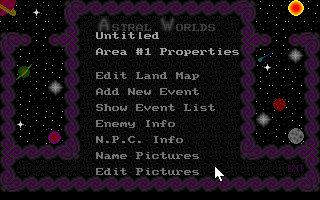 it can be a typical RPG. Battles in Astral Worlds are real time and you can't implement any kind of long range weapon in your game(like guns). Astral Worlds doesn't feature the typical RPG experience based concept of character growth. Main game character only has maximum health, offence and defense points as changeable characteristics.
it can be a typical RPG. Battles in Astral Worlds are real time and you can't implement any kind of long range weapon in your game(like guns). Astral Worlds doesn't feature the typical RPG experience based concept of character growth. Main game character only has maximum health, offence and defense points as changeable characteristics.
Overall, a very nice attempt. Might be suitable for kids who want to learn the basics of game design and can't code. The world editor is well designed and I doubt it can ruin anyone's sense or talent for game design. As for serious usage this editor simply fails to satisfy a more demanding user. I'm not saying you shouldn't use it. I just can't imagine someone being willing to cripple his game so much and leave it open for editing. But I doubt the designer ever had big expectations with this editor. The concept and the design of the editor show a lot of potential and this is something that really wouldn't be bad to remake and highly advance in FreeBASIC.
A note: From time to time, while working in the world editor, program might interrupt and return you to QBasic IDE. Don't worry, this happens very rarely and only upon entering a certain menu. Each time you leave any menu your changes are saved so no fear for your changes to be lost. You can usually return to the editor by pressing F5 in the IDE but not always.
5/10
The Game - Chief Dojoepa!
Chief Dojoepa! is a game made inside the Astral Worlds world editor and it really shows the full potential of the editor.
Being an Astral Worlds game Chief Dojoepa! features a specific design of the screen, controls, battle system and tile by tile movement. The very in-game screen is well designed. 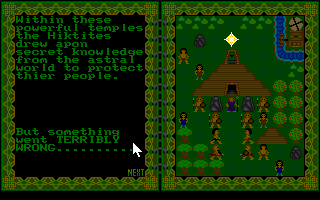 It does feature a rather small map space, placed in the left part of the screen, but this only adds a certain charm to the game and I don't consider it to be a notable flaw. In the top-right part of the screen is the game inventory, item equipping controls and the status screen, with information about character's health, offence and defense points and score. In the down-right part of the screen is the text box, an important part of the gameplay. Text box is used to display various messages, from objects you bump into to dialogues. Also, this box is used in small shops and other places where you need to pick between few options.
It does feature a rather small map space, placed in the left part of the screen, but this only adds a certain charm to the game and I don't consider it to be a notable flaw. In the top-right part of the screen is the game inventory, item equipping controls and the status screen, with information about character's health, offence and defense points and score. In the down-right part of the screen is the text box, an important part of the gameplay. Text box is used to display various messages, from objects you bump into to dialogues. Also, this box is used in small shops and other places where you need to pick between few options.
The game graphics are one of the best parts of Chief Dojoepa! featuring well drawn and designed sprites and tiles. The graphics do seem a bit EGA-like but absolutely nothing negative you can say regarding their quality. Not a single tile seems out of place or wrong. Astral Worlds doesn't allow for walk animation to be implemented in a game but you really don't miss it in Chief Dojoepa! All the characters are well and skillfully drawn and the attack(swing) animations are flawless. Since Astral Worlds allows four different areas per world this game features four different tilesets. On the very beginning of the game, after you leave your house, you might feel that the animation feature of the world editor was slightly abused since the village looks a bit like a carnival.
Chief Dojoepa! story is quite cool with not so common theme in computer games. It starts with a story about ancient Hiktite Indians who lived on a group of islands long time ago. They've built sacred giant pyramids and inside these temples drew upon secret knowledge from the astral world to protect their people. They've lived in peace and prosperity for eight hundred years until evil and malicious spirit Volgare pillaged the four Sun God temples and started creating monsters to enslave all the Hiktites. You play the role of Dojoepa, the protectors of the last Hiktite tribe, and have to stop evil Volgare and save your people. Some might find the story too cliché but it reminds me on the good old days when the stories were sweet, simple and, pardon my French, bullshit-free.
Chief Dojoepa! gameplay is pretty much the result of the world editor features. You will learn very early in the game that your goal is to find the 4 sun stones and to restore them on the sun altars in the sun temples. Uh, the Indians and their fixation with the sun. To accomplish that you will have to explore over 10 temples spread around 4 islands. To enter the sun temples you will have to find the golden idols(they look like masks) in order to unlock them. Sun temples need from 1 idol up to 4 idols to unlock them. You start the game inside your house and you shouldn't leave it before getting the spear. Unfortunately, Dojoepa is drawn like he already caries a spear which might confuse some people. Just don't leave the house until you solve this "get the spear" puzzle and equip it. Battles in Chief Dojoepa! are real time. The very fighting is not rocket science nor it requires some skill. You simply need to meet with a monster and tap on the SPACE key. Not with some crazy frequency but reasonably fast. 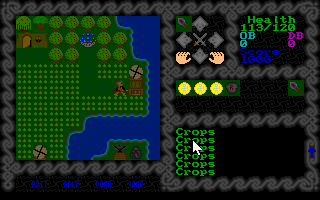 Not all prefer this kind of battle system but I found it more amusing than those typical RPG, turn-based battles. A matter of taste. Items that help you in your quest are berries, potions, coins and rune stones. With coins you buy or pay various things in the game and it's good to have them. I recommend you collect and drop coins in one or few places inside the game since you never know when you might need them. Potions and berries help you restore your health. I don't recommend using berries and potions unless you really need to(you are in the middle of some nasty temple) since they are more useful when used with various wells. Rune stones are very useful objects which have the power to bring you back home from any location but don't use them for that! Rune stones are crucial in making your character stronger. By dropping them in Wells of Offence or Defense you can increase your offence or defense points. Also, this is important, the well in your village restores your health for free! You just need to keep bumping with it. I missed that with my first two attempts to finish the game and almost gave up on it since I thought it was too difficult. It's impossible to finish Chief Dojoepa! if you don't use the well in your village to restore the health now and then. Chief Dojoepa! gameplay mostly consists of exploring various temples, finding golden idols to unlock the sun temples, finding sun stones and restoring them on the sun altars. You will also find keys which are crucial and rune stones which should be used to make your character stronger. During all that you need to avoid or kill monsters. Chief Dojoepa! is not terribly linear like Elysian Fields or Dies Irae(ugh!) but there is a certain order you need to follow to be able to finish it. It's advisable that you visit the sun temples by order(first the one that requires one idol to unlock it, then the one that requires two idols and so on). Still, Chief Dojoepa! allows a lot of freedom in the sense of character growth, items usage and ways of exploring temples.
Not all prefer this kind of battle system but I found it more amusing than those typical RPG, turn-based battles. A matter of taste. Items that help you in your quest are berries, potions, coins and rune stones. With coins you buy or pay various things in the game and it's good to have them. I recommend you collect and drop coins in one or few places inside the game since you never know when you might need them. Potions and berries help you restore your health. I don't recommend using berries and potions unless you really need to(you are in the middle of some nasty temple) since they are more useful when used with various wells. Rune stones are very useful objects which have the power to bring you back home from any location but don't use them for that! Rune stones are crucial in making your character stronger. By dropping them in Wells of Offence or Defense you can increase your offence or defense points. Also, this is important, the well in your village restores your health for free! You just need to keep bumping with it. I missed that with my first two attempts to finish the game and almost gave up on it since I thought it was too difficult. It's impossible to finish Chief Dojoepa! if you don't use the well in your village to restore the health now and then. Chief Dojoepa! gameplay mostly consists of exploring various temples, finding golden idols to unlock the sun temples, finding sun stones and restoring them on the sun altars. You will also find keys which are crucial and rune stones which should be used to make your character stronger. During all that you need to avoid or kill monsters. Chief Dojoepa! is not terribly linear like Elysian Fields or Dies Irae(ugh!) but there is a certain order you need to follow to be able to finish it. It's advisable that you visit the sun temples by order(first the one that requires one idol to unlock it, then the one that requires two idols and so on). Still, Chief Dojoepa! allows a lot of freedom in the sense of character growth, items usage and ways of exploring temples.
Another important part of the Chief Dojoepa! gameplay are movable objects, in this game stones and pillars, which on quite few places form Sokoban type of puzzles. What some might find annoying is that you can block a path to a certain important location, like a temple, and only find out later in the game that you can't finish it because of that mistake. This can be very frustrating but makes the game very challenging. You need to be very careful when pushing stones in this game and to save before doing that. There are two areas on the islands map which are tricky but not difficult. Read the strategy guide I wrote if you need help in that department. What makes Chief Dojoepa! even more challenging are secret passages and temples are full of them. You simply need to bump into a wall where you suspect for a secret passage to be. Another thing that some might find annoying while other a great feature which adds a lot to the challenge value of the game.
Two things I didn't like in the gameplay. First, locked doors. There is no any logic in which door requires 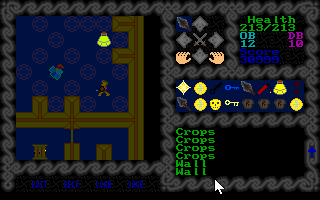 which key so in the later temples, with every new door you encounter, you have to try out every key you carry to find out which one opens it. Even one "puzzle" in a certain temple is based on a door labyrinth that requires nothing but patience in key switching. Second, monster reviving. On most of the locations, after you revisit them, monsters will be revived. This is also a matter of taste. I simply don't like this kind of feature in games. I want for monsters I kill to remain dead. By the way, monsters you kill don't increase you character's strength in any way, only your score.
which key so in the later temples, with every new door you encounter, you have to try out every key you carry to find out which one opens it. Even one "puzzle" in a certain temple is based on a door labyrinth that requires nothing but patience in key switching. Second, monster reviving. On most of the locations, after you revisit them, monsters will be revived. This is also a matter of taste. I simply don't like this kind of feature in games. I want for monsters I kill to remain dead. By the way, monsters you kill don't increase you character's strength in any way, only your score.
You will meet a lot of NPCs inside the game which are a source of more or less useful information.
What K.D.A.G. really succeeded with Chief Dojoepa! is to create an illusion of space and diversity and you really feel that this game is much larger than four 50*50 tiles large maps. I can only applaud him for cramping so much content on so little space.
The spelling in Chief Dojoepa! is not that good and on few place slightly amusing. A small minus.
I found Chief Dojoepa! very immersing and addictive and finishing it a very rewarding experience. Not all might feel like I do and might consider Chief Dojoepa! too difficult but I can't say nothing else but recommend it. Over 10 hours(if not much more) of playing it and 3 attempts to finish it must mean something. Just have in mind that Chief Dojoepa! is a tile by tile scrolling game, without Sound Blaster sound effects and music and without spectacular graphics. Chief Dojoepa! is excellent gameplay in it's purest form.
6/10
Conclusion
Astral Worlds is definitely something worth being downloaded. If for nothing else, then because of Chief Dojoepa! I hope I made someone curious enough to check out this interesting piece of work.
To download a slightly edited version of Astral Worlds(some annoying bugs removed and few notable corrections like the removal of hard paths) with a strategy guide and a game demo made by me(The Unknown) inside the world editor click here: Astralworlds.zip
To download the original version of Astral Worlds(untouched by my dirty hands) click here: AWS1.zip
Both version work only in Windows 95(I think) and above(it works in Windows XP) and not in DOS since K.D.A.G. used spacing in the names of his program files and DOS can't read that kind of files.
That was it for this first issue of Searching For The Unknown. Astral Worlds really took more time than I thought it would. For the next issue something more obscure, Star Trek: The Capture. I only played it for 30 minutes so far so can't tell what kind of game it really is. Stay tuned if you dare! :P